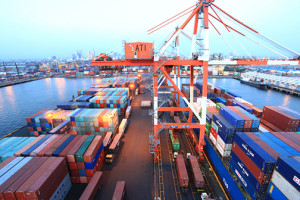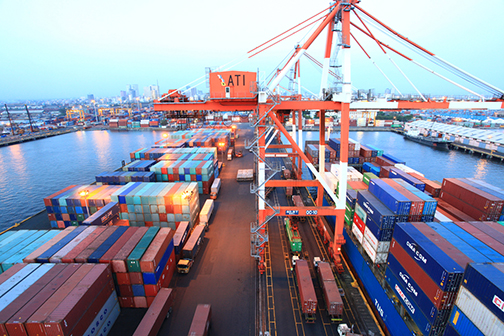
Truck ban drags MICT volume, brings congestion to Batangas
Manila’s two international container terminal operators posted increases in their income for the first three quarters of the year.
But operations of International Container Terminal Services, Inc (ICTSI) and Asian Terminals Inc (ATI) were impacted in different ways by the Manila daytime truck ban, imposed in February but indefinitely lifted in September. Volumes at ICTSI’s flagship Manila International Container Terminal were down due to the ensuing port congestion; at ATI’s Batangas Container Terminal (BCT), they were up following greater use of the facility by shippers looking for alternatives to congested Manila ports.
ICTSI’s net income from January to September was up 5% to $135.7 million from $128.8 million earned in the same period in 2013. Revenue grew 25% to $779.2 million from $624.7 million.
ATI’s net income for the same period was 60.3% higher at P1.4 billion from P870.29 million. Excluding unrealized foreign exchange gains attributed to port concession rights payable, ATI said income would be P1.3 billion, 15% higher year-on-year. Revenue for January to September 2014 rose 22.87% to P5.946 billion from P4.84 billion.
ICTSI operations
In a disclosure to the Philippine Stock Exchange, ICTSI said it benefited from higher container volumes with the launch of its new terminals in Manzanillo, Mexico (CMSA) and Puerto Cortes, Honduras (Operadora Portuaria Centroamericana, S.A. de C.V or OPC), as well as from a more favorable volume mix and increased revenues from ancillary services at several existing terminals.
However, the growth was partially offset by increased depreciation charges and higher levels of interest expense driven by the start of operations at CMSA and OPC.
Net income was also bolstered by the sale of its non-operating subsidiary in Cebu ($13.2 million), termination of the management contract in Kattupalli, India ($1.9 million), and restructuring of operations in Yantai, China ($31.8 million). These gains were reduced by a onetime non-cash charge of $38.1 million arising from the write-down of intangible assets at the company’s terminal in Buenos Aires, Argentina (TECPLATA S.A.). Excluding these non-recurring items, net income in the first nine months was $126.3 million, or 2% lower than the $128.8 million reported in the prior-year period.
For the third quarter alone, port revenues increased 27% to $268.9 million from $211 million. Net income declined 26% to $34.1 million from $45.9 million mainly due to start-up costs and consolidation of operating expenses at the new terminals, lower capitalized borrowing cost at CMSA, and recognition of a $38.1-million impairment charge on intangible assets at TECPLATA. Excluding the non-recurring items, net income declined 10% to $41.2 million.
For the first nine months, ICTSI handled 5.41 million twenty-foot-equivalent units (TEUs), 17% higher than its reported 4.628 million TEUs in the same period in 2013.
The volume increase was attributed to CMSA and OPC opening; consolidation of terminal operations at the Port of Yantai in China; and 23% volume growth at the Baltic Container Terminal (BCT) in Gdynia, Poland. Without the two new terminals, organic volume growth was flat.
The company’s seven key terminal operations in Manila, Brazil, Poland, Madagascar, China, Ecuador and Pakistan, which grew 4%, accounted for 70% of the port operator’s consolidated volume in the first nine months of 2014.
For the third quarter alone, total throughput was 15% higher at 1.844 million TEUs compared to 1.601 million TEUs in 2013. However, without the volume from the new terminals, organic volume growth was minus 1%, “principally due to the negative effect of the truck ban and related congestion issues at MICT,” ICTSI said.
The company’s Asia operations, which accounted for 60.8% of the total, reported a 3% decline to 2.729 million TEUS from 2.813 million TEUs, mainly due to lower volume at MICT in the wake of the modified truck ban policy of the City of Manila earlier in the year.
Other reasons for the reduced volumes in the region included the decline in volume at the Davao Integrated Port and Stevedoring Services Corp. due to a newly opened port; weaker imports and exports at Mindanao International Container Terminal Services, Inc., softened by the favorable impact of consolidation at the Yantai International Container Terminal; increased vessel calls at Subic Bay International Terminal servicing industries in Central and North Luzon; and a new shipping line at Pakistan International Container Terminal.
Volume in the Europe, the Middle East and Africa (EMEA) region went up 12.6% to 670,841 TEUS from 595,977 TEUs, while traffic at terminals in the Americas reported a 64.9% jump from 1.219 million TEUs to 2.01 million TEUs.
Capital expenditures for the first nine months of 2014 amounted to $177.2 million, about 57% of the $310 million capital expenditure budget for full-year 2014.
ICTSI said the budget was mainly allocated for the completion of the first phase of development at its new container terminals in Mexico and Argentina, and development of the terminals in Honduras and Democratic Republic of Congo. In addition, ICTSI invested $39 million in SPIA, its joint venture container terminal development project with PSA International Pte Ltd in Buenaventura, Colombia. The company’s expected share for 2014 is about $120 million.
Asian Terminals
ATI, which also operates the Manila South Harbor, cited the rapid growth of international containers handled by BCT, with volumes rising over 560% by end-September, as among the contributors to its financial growth. BCT’s nine-month volume is already four times higher than its full-year throughput in 2013.
For the whole of 2013, the Southern Luzon hub handled 11,019.5 twenty-foot-equivalent units (TEUs).
Higher volumes of international non-containerized cargoes handled by ATI’s ports in Batangas and Manila also contributed to the positive performance.
In a statement, ATI said BCT, which it described as “the best port gateway for Calabarzon (Cavite, Laguna, Batangas, Rizal and Quezon),” provides “an increasingly comprehensive port alternative to shippers amid the trucking and logistics constraints experienced in Manila in recent months.”
Every week, vessels call the port to connect shippers to Hong Kong, Singapore, Taiwan, Japan, Indonesia, and other key regional and global markets.
BCT is equipped with two modern quay cranes, four rubber-tired gantry cranes, side loaders, yard trucks, and other cargo handling equipment, enabling it to handle an annual volume of 360,000 TEUs.
With the brisk container growth, ATI said it is continuously optimizing vessel, yard, and gate processes at BCT through systems and technology upgrades. The latest system upgrade goes live in the third week of November.
Maersk Line’s limited ship calls to Batangas
According to PortCalls sources, the higher volumes handled at BCT have resulted in congestion.
On October 24, Danish carrier Maersk in a web advisory temporarily limited ship calls to Batangas port, saying productivity in the port has “worsened over the past several weeks.”
In its advisory, Maersk Line said, “The slowdown in the operations at the Batangas port in the Philippines lead to increased waiting time at the port affecting vessel turn time and resulting (in) delays.
“In an effort to relieve the pressure in the Batangas port, please note that we will be temporarily limiting shipments to an absolute minimum. This will be done during booking stage at the origin of your cargo and will not affect the shipments that are already in the water,” the carrier said.
No update on the situation has been published on the Maersk Line website as of Nov 14.
Adjusted MCC congestion surcharge
Meanwhile, effective November 1, 2014, MCC Transport Philippines adjusted the congestion surcharge for all intra-Asia imports (applicable to both SOC and COC dry and reefer containers) into Batangas.
The new rate levels for the surcharge are as follows: US$225 (20-footer), $450 (40-footer) and $510 (45-footer).
The surcharge is payable in Batangas and shall be collected from the consignee irrespective of freight terms, MCC said on its website. – Roumina Pablo





